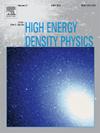一个非线性时空分数量子力学系统的分岔分析、混沌、灵敏度和不同的孤子解与传播见解
IF 0.9
3区 物理与天体物理
Q3 PHYSICS, FLUIDS & PLASMAS
引用次数: 0
摘要
本文用改进的Sardar子方程方法合并了非线性分数阶Schrödinger方程的孤立波解。在非相对论量子力学中,非线性分数阶Schrödinger方程数据的重要性源于这些方程能够描述超出传统模型范围的复杂物理现象。利用上述计算方法,我们以暗、亮-暗、暗-亮、周期、奇异、有理和指数形式展示了新的孤子解,这是以前没有报道过的。与其他最近的分析方法相比,本文采用的改进的Sardar子方程格式更通用,可以产生更丰富的孤子结构谱,同时降低了计算复杂度。这种比较优势强调了目前工作的新颖性,并突出了其对非线性分数模型的有效性。随后,从分岔分析、混沌行为和灵敏度等角度分析了模型的动力学特性。当施加外力时,在动力系统的临界点处出现分岔,表明混沌行为的开始。这种混沌行为通过二维图、时间序列、多稳定性分析和李亚普诺夫指数来说明。此外,采用龙格-库塔法对模型进行了敏感性分析。我们表明,我们提出的技术是有效的评估非线性分数阶Schrödinger方程与分析工具和数值模拟,提供新的见解,他们的行为和解决方案。我们的发现对物理学和应用数学的许多领域都有影响,有助于研究非线性偏微分方程的数学工具的发展,并为非线性分数阶Schrödinger方程的动力学提供了新的视角。本文章由计算机程序翻译,如有差异,请以英文原文为准。
Bifurcation analysis, chaos, sensitivity, and diverse soliton solutions with propagation insights a nonlinear spatiotemporal fractional quantum mechanics system
In this study, we amalgamate the solitary wave solutions for the nonlinear fractional Schrödinger equation by using the modified Sardar sub-equation method. The significance of data pertaining to the nonlinear fractional Schrödinger equation in nonrelativistic quantum mechanics stems from these equations’ capacity to depict intricate physical phenomena beyond the scope of traditional models. By leveraging the above-mentioned computational approach, we manifested the novel soliton solutions in the form of dark, bright-dark, dark-bright, periodic, singular, rational, and exponential forms, which are not reported in previously. Compared with other recent analytical approaches, the modified Sardar sub-equation scheme employed here is more versatile, yielding a richer spectrum of soliton structures with reduced computational complexity. This comparative advantage underscores the novelty of the present work and highlights its effectiveness for nonlinear fractional models. Subsequently, the dynamical characteristics of the model are analyzed from various perspectives, such as bifurcation analysis, chaos behavior, and sensitivity. Bifurcation occurs at critical points in the dynamical system when an external force is applied, revealing the onset of chaotic behavior. This chaotic behavior is illustrated through two-dimensional plots, time series, multistability analysis, and Lyapunov exponents. Additionally, the sensitive analysis of the model is examined using the Runge–Kutta method. We show that our proposed techniques are effective in evaluating the nonlinear fractional Schrödinger equation with analytical tools and numerical simulations, providing new insights into their behavior and solutions. With ramifications for numerous areas of physics and applied mathematics, our findings contribute to the development of mathematical tools for studying nonlinear partial differential equations and offer fresh perspectives on the dynamics of nonlinear fractional Schrödinger equations.
求助全文
通过发布文献求助,成功后即可免费获取论文全文。
去求助
来源期刊

High Energy Density Physics
PHYSICS, FLUIDS & PLASMAS-
CiteScore
4.20
自引率
6.20%
发文量
13
审稿时长
6-12 weeks
期刊介绍:
High Energy Density Physics is an international journal covering original experimental and related theoretical work studying the physics of matter and radiation under extreme conditions. ''High energy density'' is understood to be an energy density exceeding about 1011 J/m3. The editors and the publisher are committed to provide this fast-growing community with a dedicated high quality channel to distribute their original findings.
Papers suitable for publication in this journal cover topics in both the warm and hot dense matter regimes, such as laboratory studies relevant to non-LTE kinetics at extreme conditions, planetary interiors, astrophysical phenomena, inertial fusion and includes studies of, for example, material properties and both stable and unstable hydrodynamics. Developments in associated theoretical areas, for example the modelling of strongly coupled, partially degenerate and relativistic plasmas, are also covered.
 求助内容:
求助内容: 应助结果提醒方式:
应助结果提醒方式:


